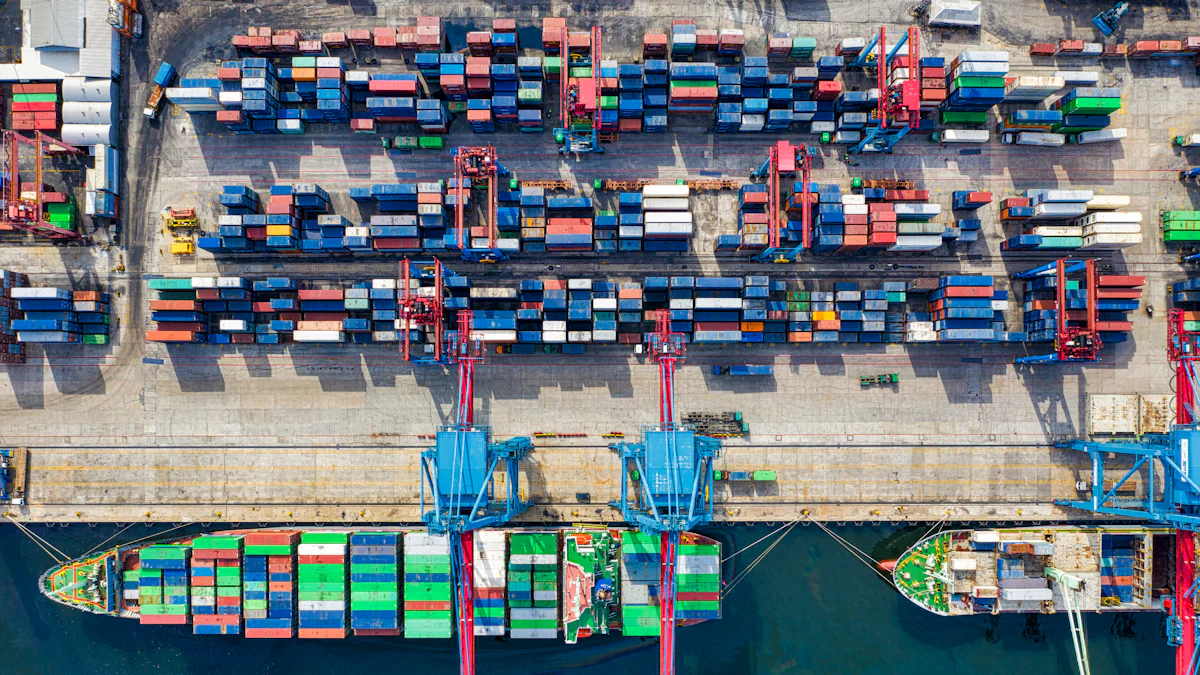Exploring Integrated Carrier Modes in Modern Logistics

Integrated Carriage combines various modes of transportation to optimize logistics operations. This approach enhances efficiency and reduces costs. Multimodal transportation offers shippers the flexibility to choose the best combination of transport modes. This leads to faster delivery times and improved environmental sustainability. Technological advancements play a crucial role in this process. Organizations use advanced analytics and AI-driven tools for accurate demand forecasting. These tools analyze extensive datasets for route optimization and predictive analytics, ensuring better access to markets and reducing risks.
Understanding Integrated Carriage
Definition and Components of Integrated Carriage
Integrated Carriage plays a crucial role in modern logistics by combining different modes of transportation for optimal efficiency. Multimodal Transportation involves the use of various transportation methods under a single carrier or Bill of Lading. This approach allows for seamless transitions between transport modes, enhancing flexibility and reducing complexity. Each mode is managed separately, which may require different types of equipment.
Intermodal Transportation, on the other hand, uses standardized equipment across different modes. A single entity manages the entire shipment process, ensuring cost-effectiveness and streamlined operations. The responsibility lies with one provider, which simplifies coordination but may offer less flexibility compared to multimodal options. Understanding these differences is essential for selecting the right strategy in Integrated Carriage.
Benefits of Integration
Integrated Carriage offers several benefits that enhance logistics operations. One of the primary advantages is Cost Efficiency. By optimizing the combination of transport modes, companies can reduce overall expenses. Standardized equipment in intermodal transportation further contributes to cost savings.
Improved Delivery Times are another significant benefit. Integrated Carriage ensures faster transit by selecting the most efficient routes and modes. This leads to timely deliveries, which is crucial for meeting customer expectations and maintaining competitiveness in the market.
The Environmental Impact of Integrated Carriage is also noteworthy. By optimizing transportation modes and routes, companies can reduce their carbon footprint. This approach supports sustainability goals and aligns with global efforts to minimize environmental harm.
Technological Advancements in Logistics

Role of Technology in Integration
Technology plays a pivotal role in the success of Integrated Carriage. Advanced systems enhance efficiency and streamline operations. One such system is the Transportation Management System (TMS). TMS provides a centralized platform for managing transportation operations. Real-time tracking capabilities allow companies to monitor shipments closely. Automation features reduce manual intervention, leading to improved efficiency. Optimization tools help in selecting the best routes and modes. These features result in cost reduction and increased customer satisfaction.
The Internet of Things (IoT) also contributes significantly to Integrated Carriage. IoT devices collect data from various sources within the supply chain. This data enhances visibility and responsiveness. Companies use IoT-driven automation to optimize processes. This leads to lower operational risks and improved efficiency. IoT enhances competitiveness within global supply chains.
Case Studies
Successful Implementations
Several companies have successfully implemented technology in Integrated Carriage. Company A used TMS to centralize its transportation operations. The company achieved significant cost savings and improved delivery times. Real-time tracking enhanced customer satisfaction. Company B integrated IoT devices into its logistics network. The company experienced enhanced supply chain visibility. Automation led to reduced operational risks and increased efficiency.
Lessons Learned
Successful implementations provide valuable lessons for Integrated Carriage. Companies should prioritize real-time tracking capabilities. This enhances customer satisfaction and operational efficiency. Automation features reduce manual errors and improve cost-effectiveness. IoT integration enhances visibility and responsiveness. Companies should leverage these technologies to stay competitive.
JUSDA's Role in Integrated Carriage
JUSDA's Multimodal Transportation Solutions
JUSDA plays a significant role in Integrated Carriage by offering comprehensive multimodal transportation solutions. The company integrates various modes of transport to optimize logistics operations.
Ocean Freight
JUSDA provides robust ocean freight services as part of its Integrated Carriage strategy. The company utilizes a mature global network to ensure stable space allocation for shipments. JUSDA offers both full container load (FCL) and less than container load (LCL) options. These services include value-added features such as temperature-controlled and special container transportation. The focus remains on delivering reliable and efficient ocean freight solutions.
Air Freight
Air freight forms a crucial component of JUSDA's Integrated Carriage offerings. The company maintains a rich route network, including established routes like China-Mexico-US and Vietnam-US. JUSDA plans new routes to enhance connectivity further. The company employs a three-stage consolidation service to optimize airfreight costs. This approach adapts to seasonal fluctuations using Block Space Agreements (BSA) and external resources. JUSDA ensures timely and cost-effective air freight services.
Rail Freight
JUSDA excels in rail freight as part of its Integrated Carriage solutions. The company specializes in full-container and less-than-container-load services via China-Europe block trains. JUSDA offers international Eurasian sea-rail intermodal transport. The company provides domestic multimodal transport with real-time monitoring of temperature and humidity. The focus remains on delivering efficient and reliable rail freight services.
JUSDA's Technological Innovations
JUSDA leverages technological innovations to enhance its Integrated Carriage capabilities. The company employs advanced platforms and systems to streamline logistics operations.
JusLink Platform
The JusLink Platform serves as a central element in JUSDA's Integrated Carriage strategy. The platform provides real-time collaborative capabilities for supply chain management. It integrates suppliers, manufacturers, service providers, and customers. The system enables efficient resource utilization and precise business decision-making. JUSDA uses the platform to enhance operational efficiency and competitiveness.
Cloud Warehouse Services
JUSDA offers cloud warehouse services as part of its Integrated Carriage solutions. The company integrates support for multi-channel sales through a big data platform. Automated warehousing and intelligent transfer capabilities enhance efficiency. JUSDA provides unified management of Vendor Managed Inventory (VMI) and Customer Managed Inventory (CMI). The company offers personalized VMI edge-of-production-line services. JUSDA ensures seamless integration with clients' systems through a proprietary VMI management system. The focus remains on delivering advanced warehouse planning and process design capabilities.

JUSDA Solutions
To provide you with professional solutions and quotations.
Challenges and Solutions
Common Challenges
Coordination Issues
Coordination issues often arise in Integrated Carriage due to the involvement of multiple transportation modes. Each mode may have distinct schedules, capacities, and operational constraints. These differences can lead to misalignments and inefficiencies. For instance, delays in one mode can cascade into others, disrupting the entire supply chain. Real-time monitoring plays a crucial role here. Advanced tracking systems provide immediate access to critical data. This allows logistics managers to make timely interventions. Rerouting deliveries or addressing maintenance issues promptly becomes possible. Such actions optimize operational efficiency and minimize disruptions.
Regulatory Hurdles
Regulatory hurdles present another significant challenge in Integrated Carriage. Different countries and regions have varying regulations for transportation. Compliance with these regulations is essential but can be complex. Regulatory requirements may include customs procedures, safety standards, and environmental guidelines. Navigating these regulations requires thorough knowledge and meticulous planning. Failure to comply can result in delays and penalties. Companies must stay informed about regulatory changes. Regular updates and training for staff involved in logistics operations are necessary. This ensures adherence to all legal requirements and smoothens the logistics process.
Overcoming Challenges
Strategic Planning
Strategic planning is vital for overcoming challenges in Integrated Carriage. A well-structured plan considers all aspects of the logistics process. This includes route optimization, resource allocation, and risk management. Companies should employ advanced analytics for accurate demand forecasting. Predictive analytics help identify potential bottlenecks. This allows for proactive measures to prevent disruptions. Strategic planning also involves creating contingency plans. Backup suppliers and alternative routes should be part of the strategy. This ensures continuity in operations even when unforeseen issues arise.
Collaboration with Stakeholders
Collaboration with stakeholders enhances the effectiveness of Integrated Carriage. Stakeholders include suppliers, carriers, and customers. Effective communication and coordination among these parties are crucial. Collaborative platforms facilitate real-time information sharing. This leads to better decision-making and improved efficiency. Stakeholders should work together to streamline processes. Joint efforts can address common challenges like supply shortages and labor constraints. Automation software can accelerate order fulfillment. By fostering strong partnerships, companies can enhance their logistics operations. This results in a more resilient and responsive supply chain.
Integrated carrier modes have transformed logistics by enhancing efficiency and reducing costs. Future trends indicate a shift towards sustainability and technological integration. Companies will adopt green logistics practices to meet environmental responsibilities. Advances in technology will drive efficiency and transparency. Integration remains crucial for optimizing operations and meeting market demands. The logistics industry must embrace change and innovation. Prioritizing sustainability and leveraging technology will ensure a more customer-centric approach. Businesses must adapt to these trends to maintain competitiveness and operational excellence in the evolving logistics landscape.
See Also
Ready to Explore: The Latest in Supply Chain Transport Tech
Innovative Logistics Tech: Exploring the Future Ahead
Navigating the Future: Logistics Enhanced by Digital Tech
Tomorrow's LTL Freight: An Extensive Examination
Revolutionizing Logistics: The Future with AI in Supply Chain
